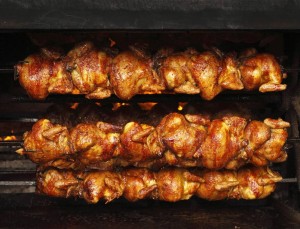I got that question from Tim Clodfetler from the Winston-Salem Journal (which came from one of his readers). I said that color isn’t the best way to assess safety.
Here’s the full question and answer exchange:
We love chicken and buy rotisserie ones often. I frequently find pink meat and juices in these store-bought chickens, especially meat closer to the bone and in larger chickens. So to be safe I often end up cooking the meat some more. Am I wrong to be concerned about pink poultry meat?
Regarding rotisserie chicken: “Color in meats and poultry is not a good indicator of safety,” said Benjamin Chapman, a food safety specialist with N.C. Cooperative Extension, in an email reply. “Meats that have not reached a safe cooking temperature can look like they are done — and vice versa (which may be happening in this reader’s situation). Chicken meat can be pink for a variety of reasons, and sometimes around the bones you can see some seepage of bone marrow into the meat itself (which may look like blood, but isn’t). But it isn’t a good representation of the safety of the meat. A thermometer, placed into the meat in multiple spots, is.”
A grocery store’s rotisserie chickens have to be cooked to at least 165 degrees Fahrenheit, he said, which is hot enough to kill Salmonella or Campylobacter that may be lurking in the raw meat.
“Often, in my experience, stores have procedures in place where staff are required to take the temperature of each chicken to confirm that is has reached a safe temperature. Often, health inspectors also check these cooking temperatures, as well as the hot-holding case temperatures.”
If you are concerned, he suggested asking the store manager for more details about cooking time, when the chickens are typically finished roasting, and whether they can confirm the endpoint temperature.
“If the reader would like to reheat the chicken further, they could cook it to 165 at home but that would almost certainly result in a lower quality meal (it may dry out),” he said.
